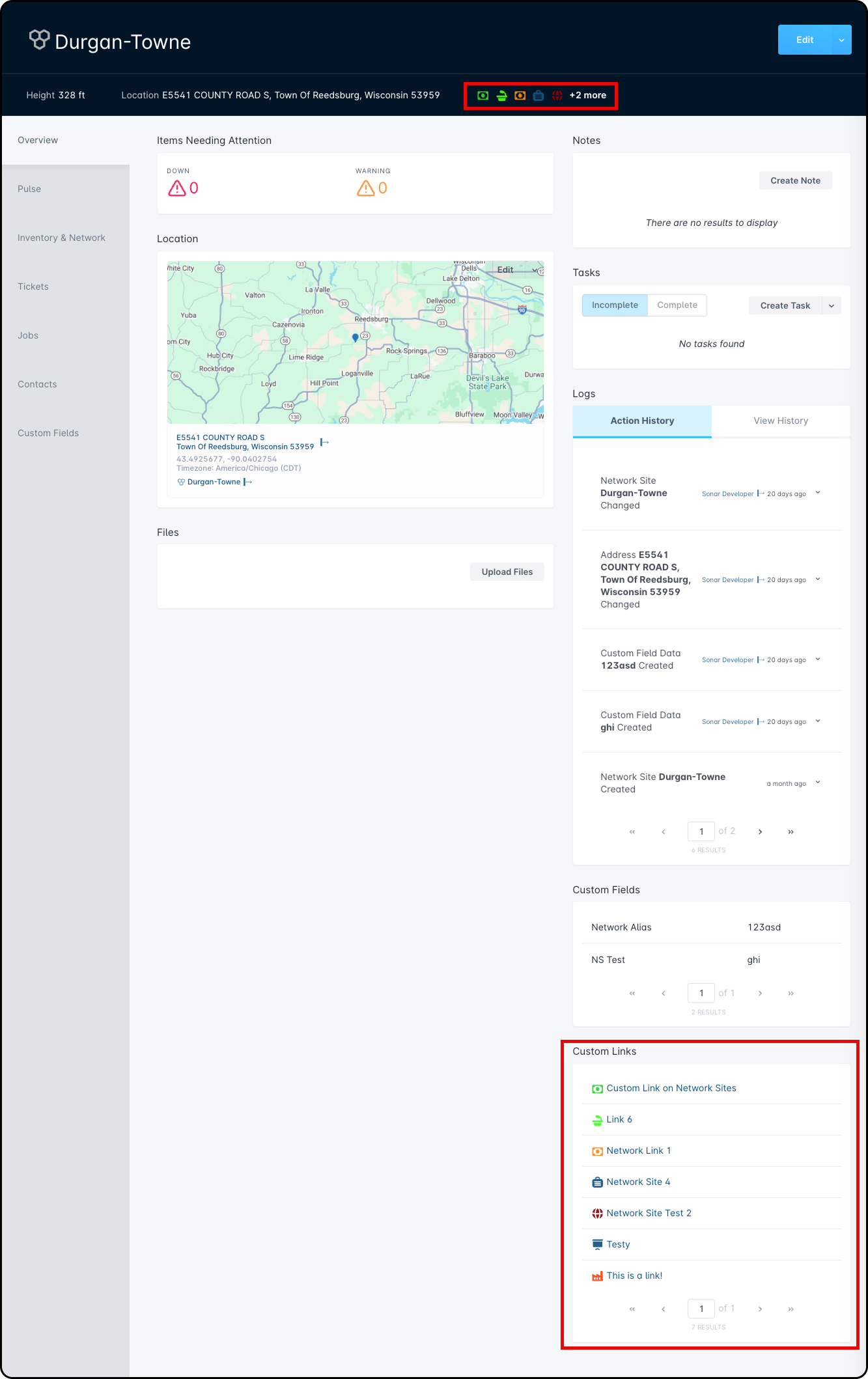Our Products & Services
Getting Started
First Time Setup
Getting Started With Jobs
Getting Started with Accounts
Getting Started with Inventory
Getting Started with Ticketing
Setting Sonar up for Billing
Baseline Configuration
How To: Using Sonar's Customer Portal
User Specific Resources
Accounts
Account Groups: Overview & Example Use Cases
Account List View: Overview
Account Management View: Overview
Account Overview Customization
Account Statuses: Overview & Example Use Cases
Account Types: Overview & Example Use Cases
Anchor & Linked Serviceable Addresses: Overview and Best Practices
Archiving an Account: Overview
CPUC Fixed Broadband Deployment by Address
Child Accounts: Best Practices & How Tos
Creating a New Account
Direct Messages: Overview
Disconnecting an Account
Disconnection Reason Management: Overview
Exploring Task Groups
FCC Broadband Data Collection (BDC) Filings: How Sonar Can Help
FCC Data Exports: General Overview and Usage
Future Serviceable Addresses: Overview
Lead Intake Form Processing
Notes: Best Practices & Use Cases
Scheduled Events: Overview & Use Cases
Serviceable Addresses: Overview and Usage
Specify Account ID upon Creation
Tasks & Task Templates: Overview
Using Sonar's FCC Broadband Label Generation Tool
Billing
ACH Batching: Overview
Accounts in Vacation Mode
Avalara: Overview & Setup
Batch Payments & Deposit Slips: Overview
Billing Calculator
Billing Defaults
Billing Settings
Building Packages
Building a Data Service
Canadian ACH tool
Changing Service Pricing in Sonar: Best Practices
Considerations When Using Avalara with Voice Services
Creating Discounts for Services and Packages
Delinquency Billing Best Practices
Delinquency Exclusions: Overview and Use Cases
Dual Data Services: Overview
Email Invoice Batch: Overview
General Ledger Codes: Overview
General Transactions: Best Practices
How Sonar Prorates Billing
How to Take Bank Account Payments
How to: Adding a Service to an Account
Invoice Templates: Overview
Leveraging PayPal as a Payment Method in Sonar
Manual Transactions
Multi-Month Billing & Multi-Month Services
Print to Mail
Printed Invoice Batches: Overview
Services: Overview
Setting Up Payment Methods and Taking Payments
Setting up Bank Account & Credit Card Processors
Taxes Setup
Usage Based Billing Policies: Overview and Usage
Usage Based Billing Policy Free Periods: Overview and Usage
Using Tax Exemptions - How To
Communication
Communications: Call Logs Overview & Best Practices
Communications: Messages Overview
Email Variables & Conditions
Message Categories: Overview & Use Cases
Phone Number Types: Overview and Use Cases
Saved Messages: Overview
Setting up an Outbound Email Domain
Trigger Explanations
Triggered Messages: Setup
Using Outbound SMS
Using the Mass Message Tool
Companies
How to: Setting Up a Company in Sonar
Managing Multiple Companies in Sonar: Best Practices
Rebranding your Sonar Instance
Financial
Contract Templates
Invoice Attachment Use Cases & PDF Examples
Invoice Messages: Overview & Use Cases
Invoices in Sonar: Examples, Creation & Contents
Integrations
Atlas Digital CORE Integration
Calix Cloud Data Field Mappings
Calix SMx Integration: Overview
CrowdFiber Integration
External Marketing Providers
GPS Tracking Providers: Overview
GoCardless Integration: Overview & Setup
How to Connect Cambium to your Sonar Instance
How to Connect Preseem to your Sonar System
How to: Using Webhooks in Sonar
Integrating with Calix Cloud
RemoteWinBox - Integration with Sonar
Sonar Retain: AI-Powered Customer Retention & Quality Intelligence
The Sonar Field Tech App
Tower Coverage Integration: Overview
VETRO FiberMap V2 Integration: Overview
VETRO FiberMap V3 Integration: Overview
Webhooks in Sonar: Basic PHP Example
iCalendar Integration
Inventory
Inventory List View: Overview
Inventory Model Management: General Overview
Network Inventory: How-to & Usage Guide
Segmentable Inventory: How-to & Usage Guide
Setup of Inventory: Manufacturers, Categories, and Assignees
Tracking and Using Consumable Inventory
Jobs
Applying Task Templates to Jobs
Edit Job Options
Example Jobs & Templates
Geofences: Overview
Job Types: Best Practices
Jobs and Scheduling: Overview
Scheduling How-to: Creating and Booking a Job
Scheduling Week View: Overview
Setting Up Schedules General Overview
Mapping
Misc.
Combining Custom Fields & Task Templates for Information Storage
Custom Fields Overview & Use Cases
Custom Links: Overview
Task Templates Overview & Use Cases
Monitoring
Building Alerting Rotations
Building a Monitoring Template
Poller Troubleshooting
Pollers: General Overview, Deployment Strategy, Build Out & Setup
Networking
Adtran Mosaic Cloud Platform Integration: Overview
Assigning RADIUS Addresses
Assigning an IP Address Using Sonar's IPAM: How to
Automating IP Assignments, Data Rates, and Network Access in Sonar
Building Address Lists
Building RADIUS Groups
Building a Device Mapper
Cable Modem Provisioning
Controlling Customer Speeds with Sonar: General Overview
DHCP Delivery
Data Usage Available Methods
Finding your OIDs
FreeRADIUS 3: Build-Out & Integration
How Sonar Communicates - Egress IPs Explained
IP Assignments & Sonar
IPAM: Basic Setup
IPAM: Overview
LTE Integration
MikroTik as an Inline Device: Integration With Sonar
MikroTik: Controlling Access
MikroTik: Controlling Speeds
MikroTik: Setting Up a Sonar Controlled DHCP Server
Netflow On-Premise Integration: Setup and Overview
Network Dashboard: Overview
Network Sites: Management View Overview
PacketLogic: Integration With Sonar
Pulse, Polling, and PHP
RADIUS: Build-Out & Integration with Sonar
RADIUS: Building Reply Attributes
Setting Up CoA Proxy
Sonar Flow
Sonar IP Addressing
Using Multiple Network Devices in Sonar
Purchase Orders
Release Notes
Reporting
Enhanced Business Intelligence - Tips & Tricks for Advanced Users
How To Enhance Your Reporting With Custom Field Data
Report Licenses
Sonar's Business Intelligence: Overview
Understanding Sonar Reports
Using Sonar DataConnect to Connect BI Applications with Your Sonar Instance
Security
Application Firewall: General Overview and Best Practices
Auth0: Overview
Multi-Factor Authentication: Overview
Password Policy In Depth
Removing a Terminated Employee In Sonar
Role Creation using GraphiQL
User Role Creation & Best Practices
Users: Overview
Sonar Billing
sonarPay
sonarPay Canada Disbursements: Overview
sonarPay Chargebacks & Disputes: Overview
sonarPay Disbursements: Overview
sonarPay Monthly Statement: Overview
sonarPay Overview
sonarPay Reversals, Voids, & Refunds: Overview
sonarPay: Token Migration Process
System
A Deeper Dive into the New Sonar API
API Calls Using Third Party Applications: Personal Access Tokens
Browser Compatibility and Minimum Hardware Requirements for Sonar
Consuming the Sonar API
Controlling Your Landing Page: Personal Preferences
Customizing Your Customer Portal
Date/Time Picker: Overview
Dynamic Time Zones in Sonar
Filtering: Overview
Frequently Used Terms
Getting Your Data into Sonar
GraphQL Rate Limiting Overview
How To Use GraphiQL to Understand the Sonar API
How Your Data is Backed Up
How to Best Use Global Search
Interacting with Files via the API
Introducing the New Sidebar
Main Menu: Overview
Mutations in the Sonar API
Notification Preferences
REST API Wrappers for V1 Compatibility
SMS Notifications
Sonar's Rich Text Editor
System Settings: Overview
The New Sonar API
Troubleshooting the Customer Portal
Upgrading your Ubuntu OS - Customer Portal Upgrades
User Profile: Your Personal User Settings
Ticketing
Advanced Ticketing Features
Canned Replies Examples & Templates
Canned Reply Categories
Exploring Ticket Groups
How Sonar Manages Spam Tickets
How to Integrate Inbound Mailboxes with Slack
Inbound Mailboxes Example Build
Ticket Category Families & Ticket Categories: Overview
Ticket Resolution Reasons: Overview
Ticketing: Overview
Using Parent Tickets
Voice
API Changes for Voice Billing
Best Practices to Remain CPNI Compliant
Billing Voice Services in Sonar
Deploying Voice Services in Sonar
Working With the Sonar Team & Additional Resources
Sonar's Security Practices & Certifications
Sonar and General Data Protection Regulation (GDPR)
Sonar's Security Strategies
Technical Security Overview
Best Practices for Fast Tracking a Support Request
Feedback Portal / Suggest a Feature
Learning with Sonar: Tools and Resources
New Client Training Overview
Sonar Casts Table of Contents
Submitting Bugs vs. Feature Requests
The Sonar Community Forum
The Sonar Status Page
Third Party Customer Support Referrals
Table of Contents
- All Categories
- Misc.
- Custom Links: Overview
Custom Links: Overview
 Updated
by Jennifer Trower
Updated
by Jennifer Trower
Read Time: 6 mins
Custom Links are designed to bring simplicity to your daily workflow. Whether you use Sonar alone or with other software providers to assist with the management of your company, having a quick, easily accessible link to a 3rd party vendor is helpful. With Custom Links, you can attach a link to select entities, such as an Account, a Ticket, a Serviceable Address, or a Network Site within Sonar. This allows you direct access to other web applications without all the hassle of copying and pasting, or using your bookmarks and opening more browser tabs manually. Clicking a Custom Link will automatically open a new browser tab and take you directly to where you want to go. Another great thing about using Custom Links in Sonar is that when you create one, you can create a unique URL using Custom Fields. This results in the URLs being unique based on the entity you are looking at.
Permissions
Before getting started with the configuration, your user roles will need to be adjusted to account for the permissions required to use the Custom Links feature.

Creating a Custom Link
Once your permissions are assigned, to create a Custom Link, you will navigate to Settings → Misc → Custom Links → Create Custom Link or select Edit or Delete if necessary.
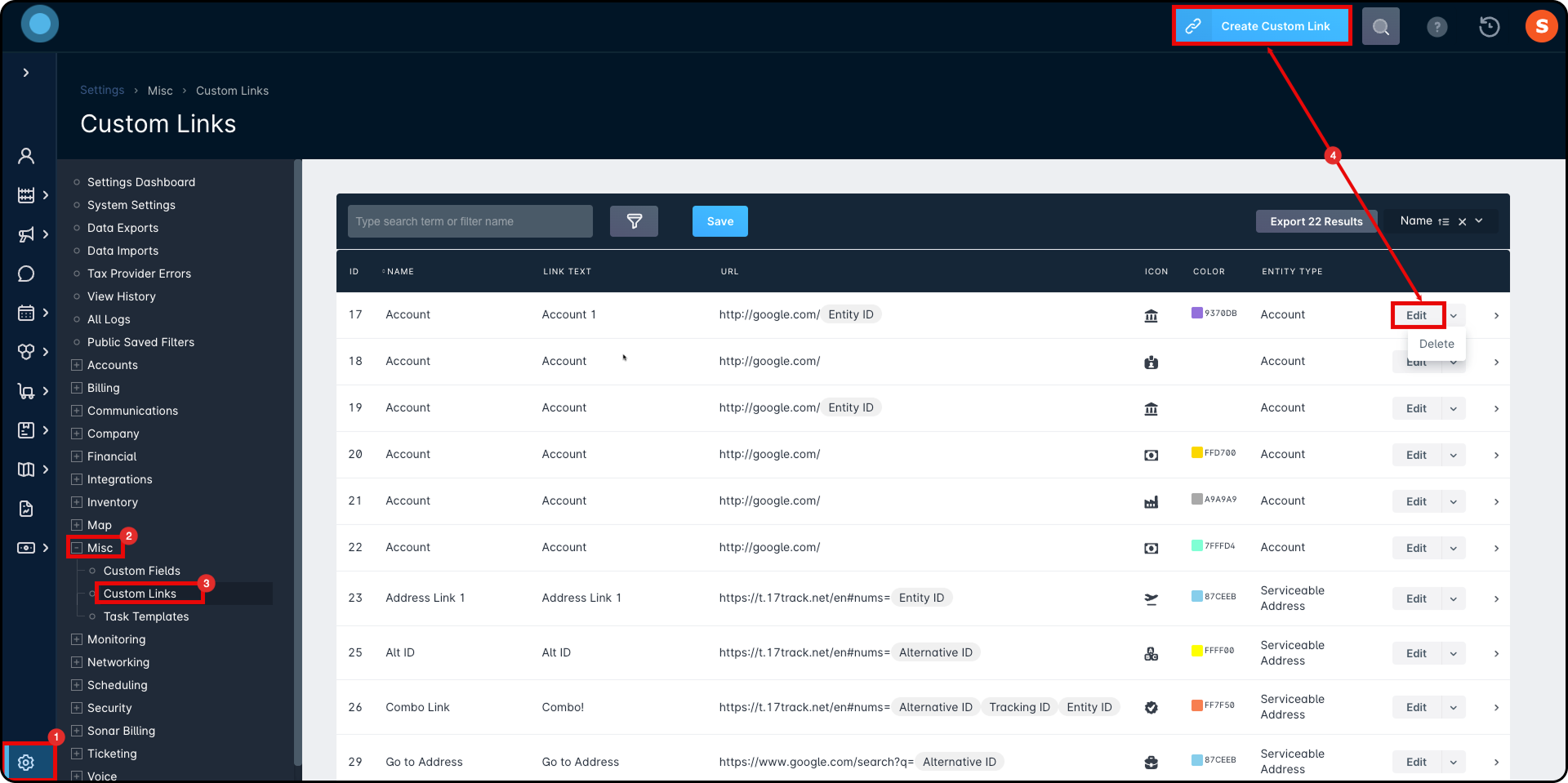
Clicking Create Custom Link will open a modal which allows you to input the necessary information that is required.
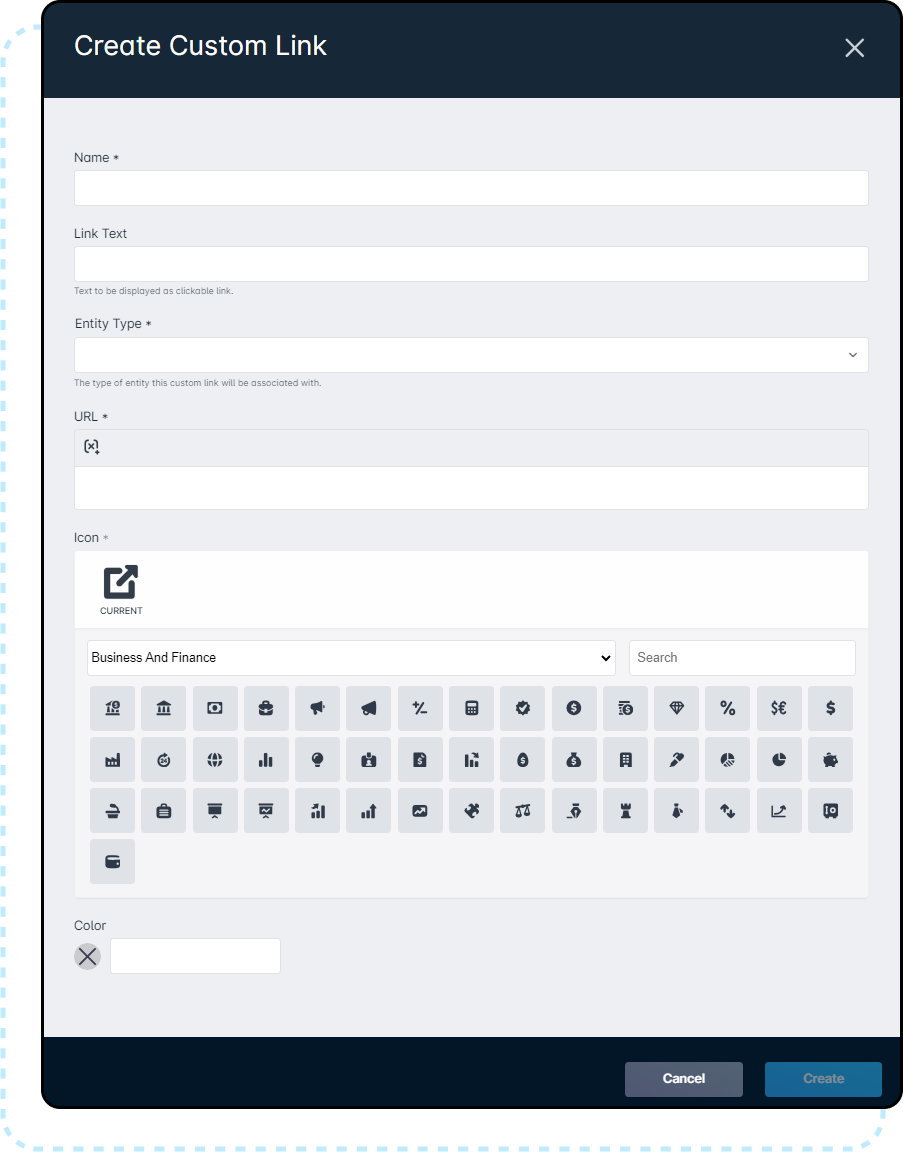
https://example.com/account/123456). To resolve this situation, you will need to create custom fields for each part of the path.
- The Name field allows you to enter a custom, descriptive name for this Custom link.
- The Link Text field is where you will enter the text that will be displayed with the Custom Link.The default filtering for our Custom Links table is done by the Link Text.
- The Entity Type field allows you to select where you want the Custom Links associated within your instance. This is a required field and controls which custom fields are available when building the URL.

- The URL field allows you to enter the URL needed for the link and select the associated Custom Field necessary to go with it. When creating the URL you are required to start the URL with https:// or http:// for it to be a valid URL entry.Only “Text” Custom Fields will be presented as variables when creating a Custom Link.
- The Icon is used to quickly identify the custom link within the Custom Link section, allowing for a quick glance selection.
- The Color picker allows you to select a visual indicator used to identify the custom link when listed in the Custom Link section of the account, as well as at the top of the account page.
Editing a Custom Link
After navigating to the Custom Links overview page, you will select the “Edit” option on the line item you which to modify.
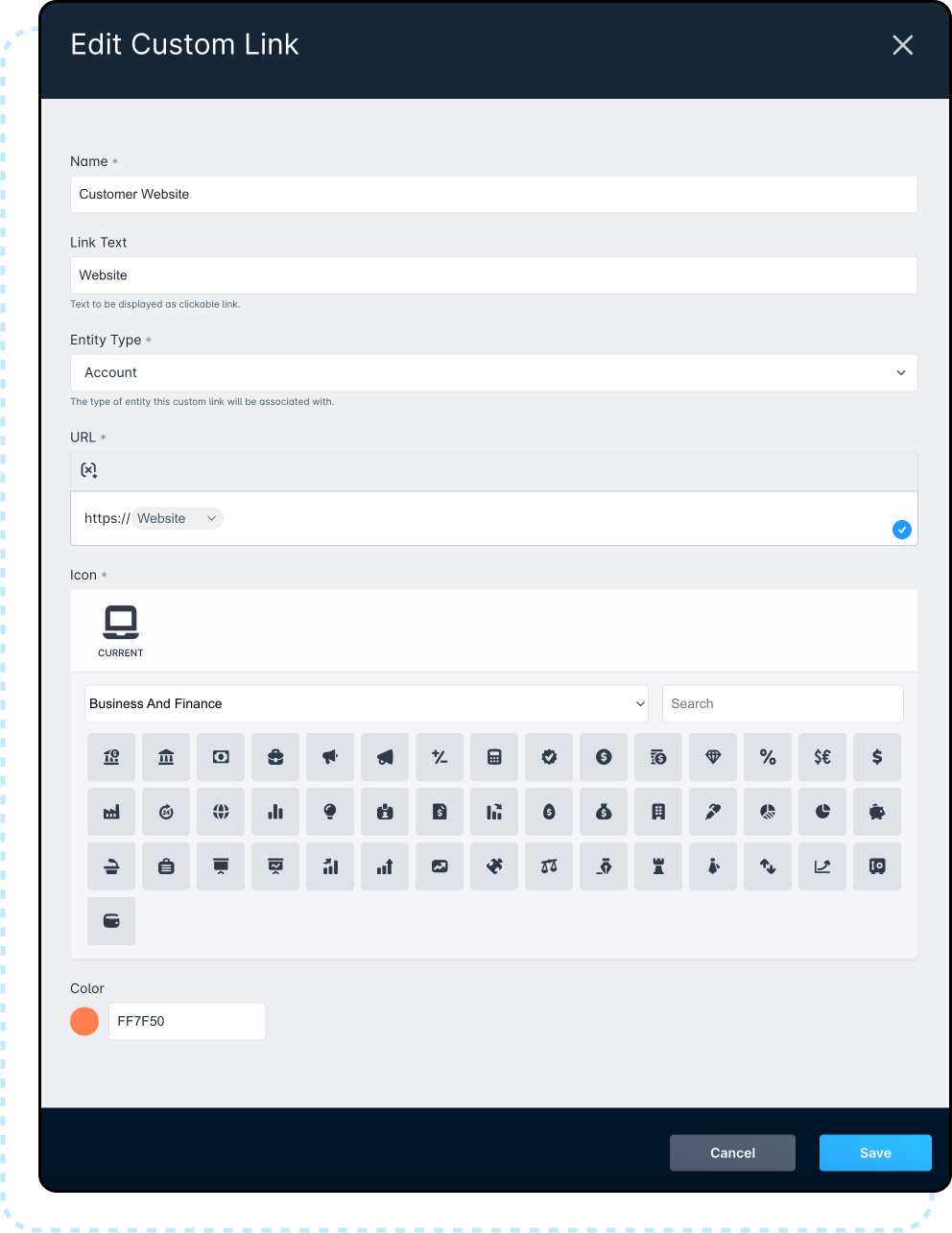
Custom Link Errors
When viewing the Custom Link table in Settings, you may come across a broken link. This link will be highlighted in red, indicating that there is an error with the link. Normally, this error is due to a Custom Field being deleted and the Custom Link no longer working, as the variable for the Custom Field is broken.

To fix this link, you will need to select the “Edit” button on the line item and open the Edit Custom Link modal. Once the window is open, you need to select a different Custom Field under the URL field, to correct this error.
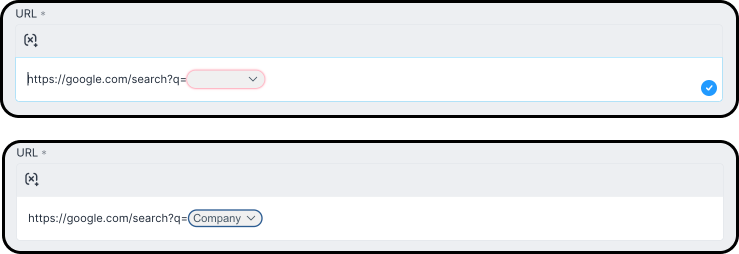
Once this is corrected, the red highlight will disappear and no longer indicate an error with the link.

Viewing a Custom Link
There are a few different places where you can view Custom Links associated with an Entity. Since Custom Links are associated with Accounts, Ticketing, Serviceable Addresses, and Network Sites, below will show where each entity will provide you access to view your Custom Links.

Accounts
Firstly, for Accounts, you can view the sidebar associated with the necessary account on the Account Management page, or navigate to a user's account where you will see Custom links in two spots within the Account Overview page.
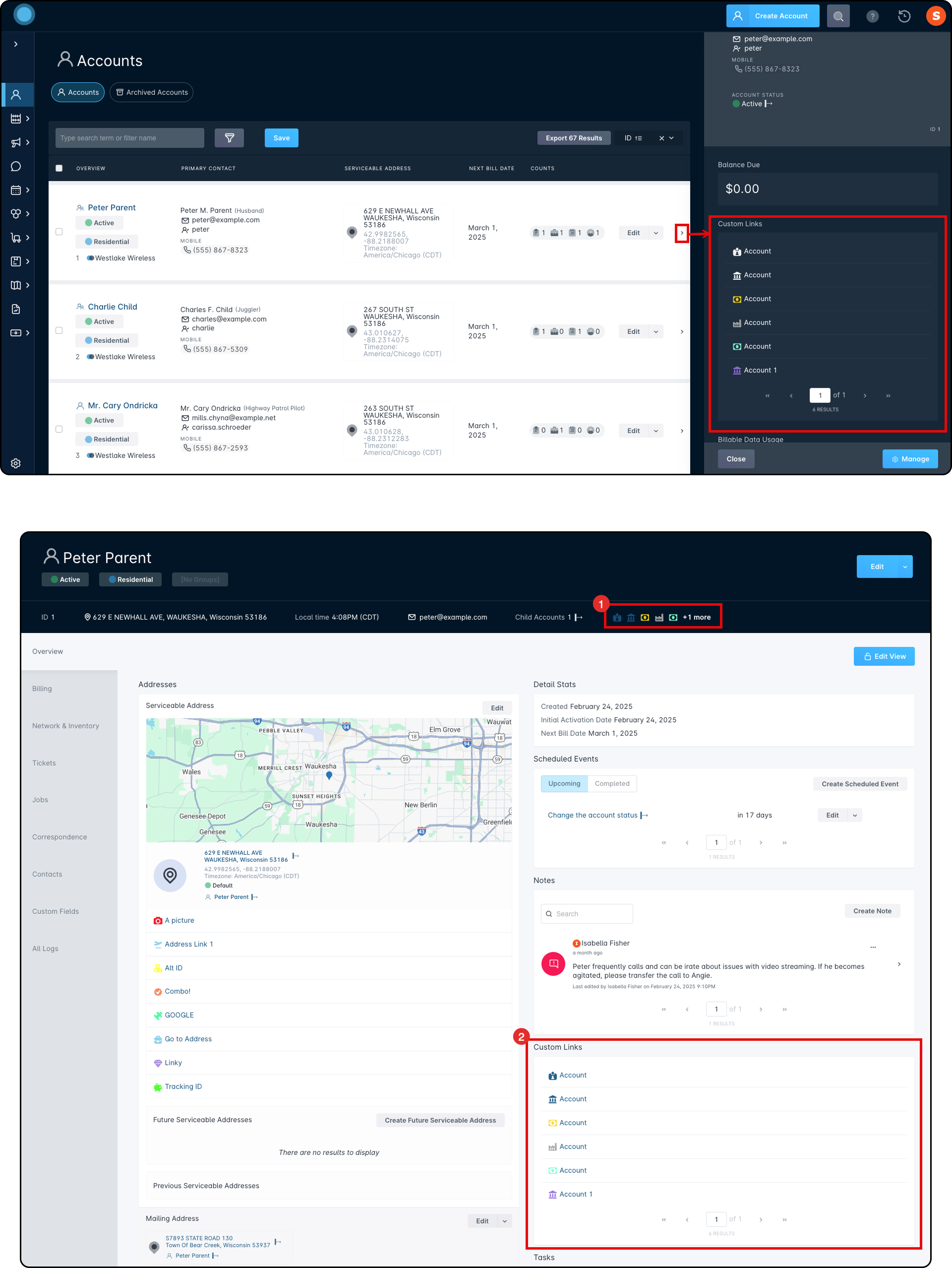
- In the Header on the Account Overview page. Here you will have access to 5 link icons with a dropdown menu to view an additional 20 custom links.

- In the Custom Links section on the Account Overview page, found below the Notes section on the page. Here, you can view up to 10 custom links per page.

Ticketing
With Ticketing, you can view Custom Links by navigating to the Ticketing tab, then selecting the arrow to open the sidebar for a line item, or you can open a ticket to view your attached links. Once you open the ticket, you will find the Custom Link icons in two places within the Ticket Overview page.
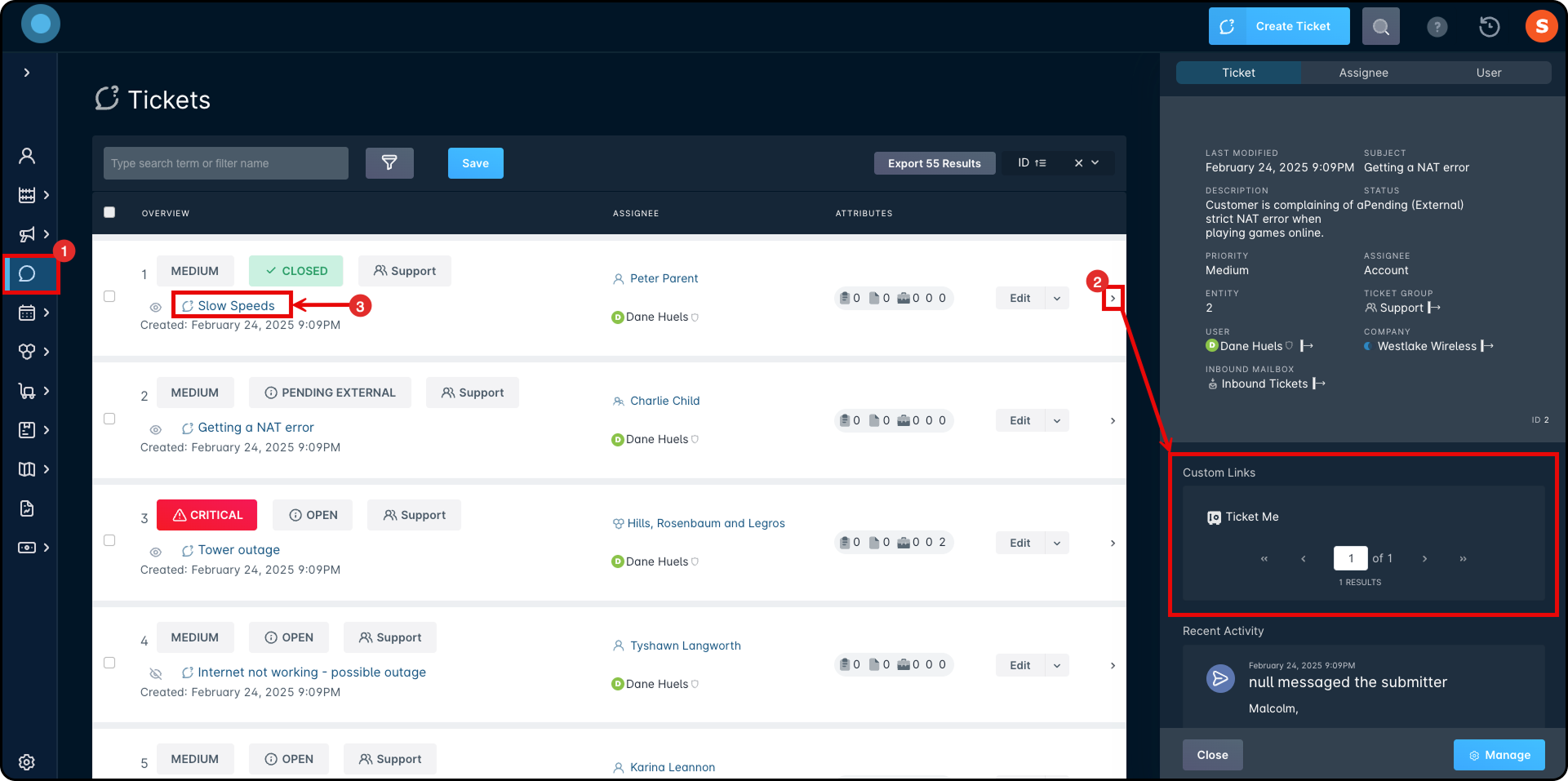
- The header of the ticket.
- Under the “Ticket Information” section on the left side of the screen.

Serviceable Addresses
Assigning Custom Links to Serviceable Addresses has the same steps as the other entities. Click Create Custom Link, fill in the required fields, along with selecting the Entity you are associating the link with, and then you save. Once the link is associated with Serviceable Addresses, you will see them in a few different areas.
- The Serviceable Addresses Management page.
- Here you will see the Custom Links in three different areas.
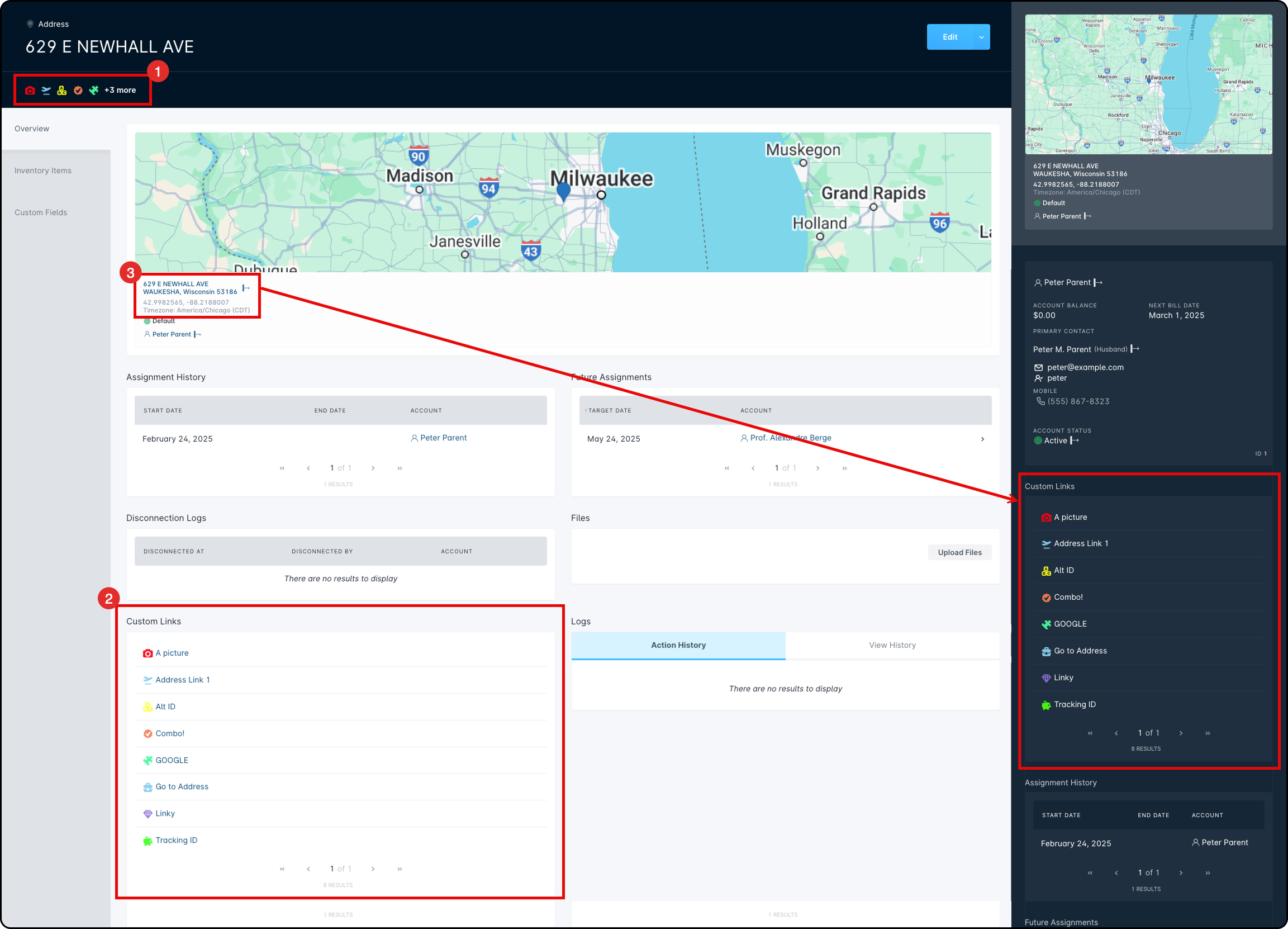
- Here you will see the Custom Links in three different areas.
- In the Serviceable Addresses card on the Account Overview Management page.
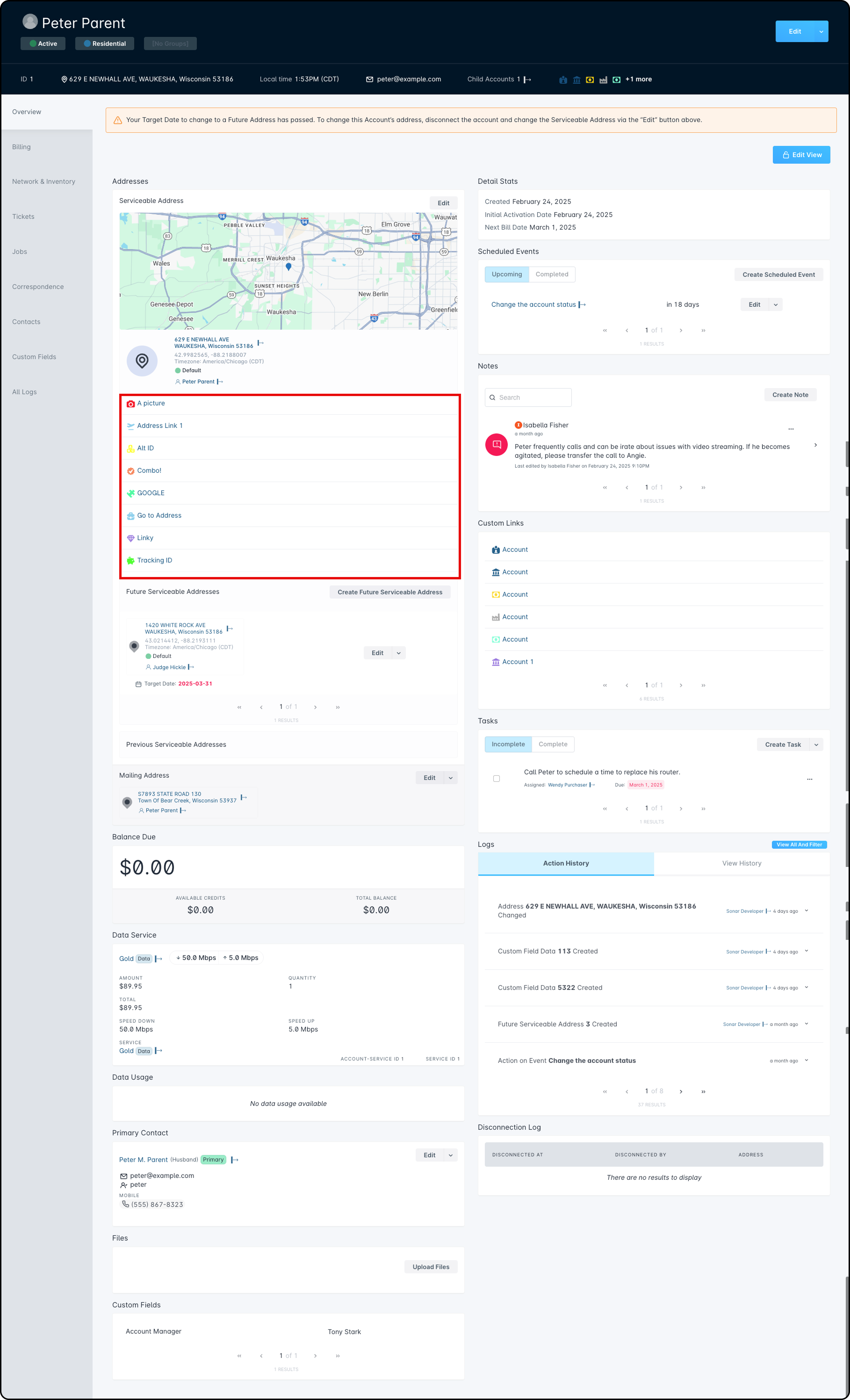 Only the Custom Links associated with the Serviceable Addresses will appear on this card.
Only the Custom Links associated with the Serviceable Addresses will appear on this card.
Network Sites
For Network Sites, you will find associated Custom Links by clicking on the arrow to open the sidebar for that individual line item.
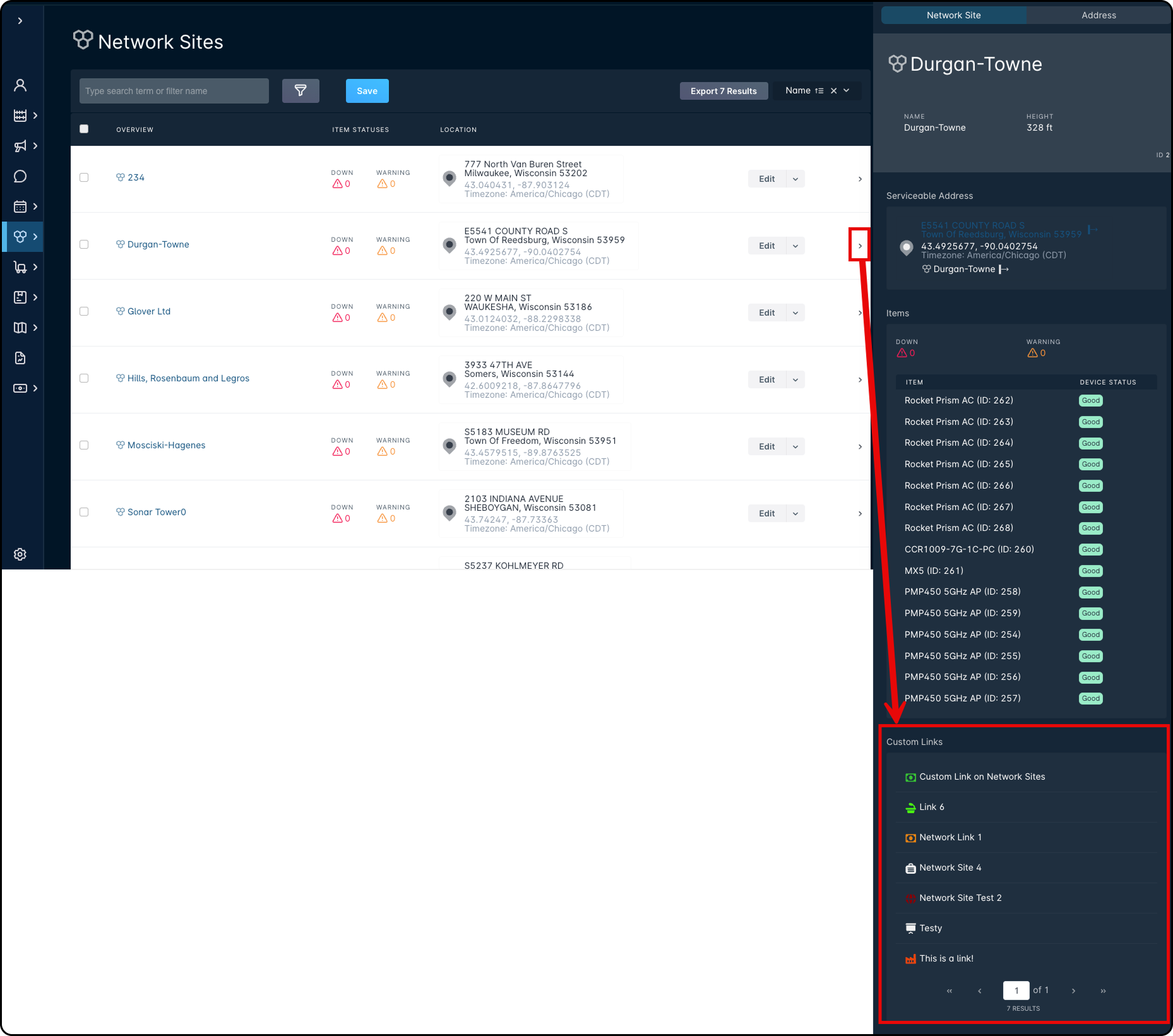
As well as on the Network Site Management page within the header and then by scrolling further down the page to find the Custom Links section.
